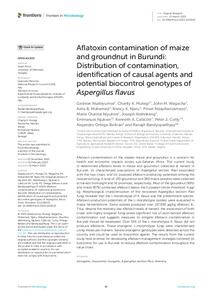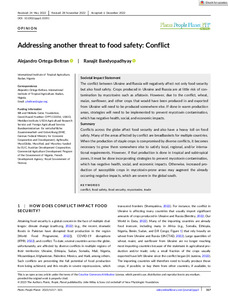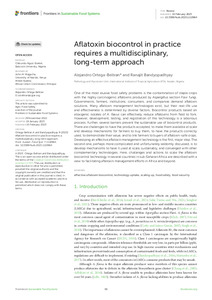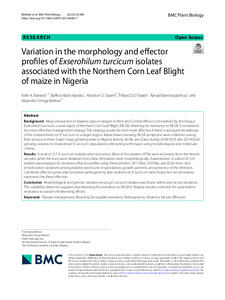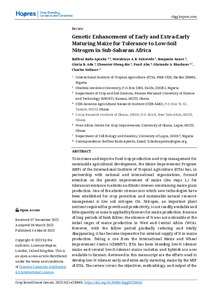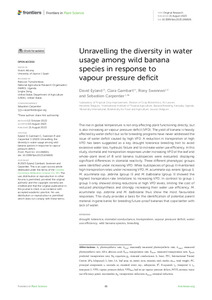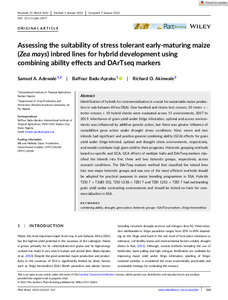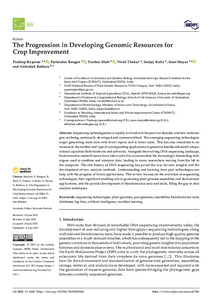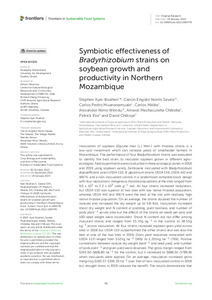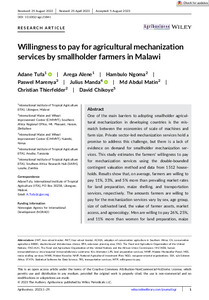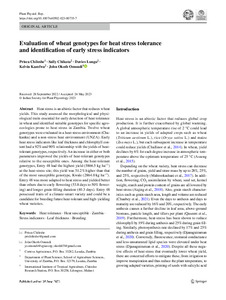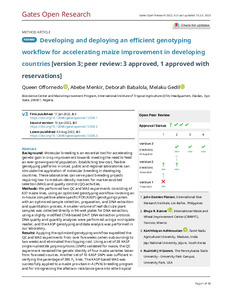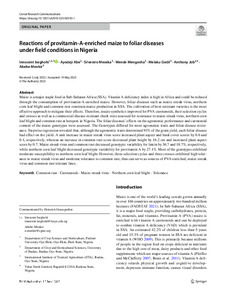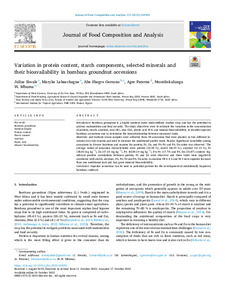Welcome to the International Institute of Tropical Agriculture Research Repository
Journal and Journal Articles: Recent submissions
Now showing items 261-280 of 5283
-
flatoxin contamination of maize and groundnut in Burundi: distribution of contamination, identification of causal agents and potential biocontrol genotypes of Aspergillus flavus
(2023-03-13)Aflatoxin contamination of the staples maize and groundnut is a concern for health and economic impacts across sub-Saharan Africa. The current study (i) determined aflatoxin levels in maize and groundnut collected at harvest in Burundi, (ii) characterized populations of Aspergillus section Flavi associated with the two crops, and (iii) assessed aflatoxin-producing potentials among the recovered fungi. A total of 120 groundnut and 380 maize samples were collected at harvest from eight and 16 ... -
Addressing another threat to food safety: conflict
(2023-01-14)Societal Impact Statement The conflict between Ukraine and Russia will negatively affect not only food security but also food safety. Crops produced in Ukraine and Russia are at little risk of contamination by mycotoxins such as aflatoxin. However, due to the conflict, wheat, maize, sunflower, and other crops that would have been produced in and exported from Ukraine will need to be produced somewhere else. If done in warm production areas, strategies will need to be implemented to prevent mycotoxin ... -
Aflatoxin biocontrol in practice requires a multidisciplinary, long-term approach
(2023-02-10)One of the most elusive food safety problems is the contamination of staple crops with the highly carcinogenic aflatoxins produced by Aspergillus section Flavi fungi. Governments, farmers, institutions, consumers, and companies demand aflatoxin solutions. Many aflatoxin management technologies exist, but their real-life use and effectiveness is determined by diverse factors. Biocontrol products based on atoxigenic isolates of A. flavus can effectively reduce aflatoxins from field to fork. However, ... -
Variation in the morphology and effector profiles of Exserohilum turcicum isolates associated with the Northern Corn Leaf Blight of maize in Nigeria
(2023-08-10)Background Maize production in lowland agro-ecologies in West and Central Africa is constrained by the fungus Exserohilum turcicum, causal agent of Northern Corn Leaf Blight (NCLB). Breeding for resistance to NCLB is considered the most effective management strategy. The strategy would be even more effective if there is adequate knowledge of the characteristics of E. turcicum in a target region. Maize leaves showing NCLB symptoms were collected during field surveys in three major maize growing ... -
The fate of nitrogen during agricultural intensification in East Africa: nitrogen budgets in contrasting agroecosystems
(2023-07-09)The intensification of agricultural systems in sub-Saharan Africa (SSA) is necessary to reduce poverty and improve food security, but increased nutrient applications in smallholder systems could have negative consequences for water quality, greenhouse gas emissions, and air quality. We tracked nitrogen (N) inputs and measured maize (Zea mays) biomass, grain yields, N leaching, and nitric oxide (NO) and nitrous oxide fluxes from a clayey soil in Yala, Kenya and a sandy soil in Tumbi, Tanzania, with ... -
Genetic enhancement of early and extra-early maturing maize for tolerance to low-soil nitrogen in sub-Saharan Africa
(2023-03-14)To increase and improve food crop production and crop management for sustainable agricultural development, the Maize Improvement Program (MIP) of the International Institute of Tropical Agriculture (IITA) has, in partnership with national and international organizations, focused attention on the genetic improvement of maize (Zea mays L.) for tolerance/resistance to abiotic and biotic stresses constraining maize grain production. One of the abiotic stresses into which new technologies have been ... -
Unravelling the diversity in water usage among wild banana species in response to vapour pressure deficit
(2023-08-21)The rise in global temperature is not only affecting plant functioning directly, but is also increasing air vapour pressure deficit (VPD). The yield of banana is heavily affected by water deficit but so far breeding programs have never addressed the issue of water deficit caused by high VPD. A reduction in transpiration at high VPD has been suggested as a key drought tolerance breeding trait to avoid excessive water loss, hydraulic failure and to increase water use efficiency. In this study, ... -
Assessing the suitability of stress tolerant early-maturing maize (Zea mays) inbred lines for hybrid development using combining ability effects and DArTseq markers
(2023-04)Identification of hybrids for commercialization is crucial for sustainable maize production in sub-Saharan Africa (SSA). One hundred and ninety test crosses, 10 tester × tester crosses + 10 hybrid checks were evaluated across 11 environments, 2017 to 2019. Inheritance of grain yield under Striga infestation, optimal and across environments was influenced by additive genetic action, but there was greater influence of nonadditive gene action under drought stress conditions. Nine, seven and two inbreds ... -
The progression in developing genomic resources for crop improvement
(2023-07-31)Sequencing technologies have rapidly evolved over the past two decades, and new technologies are being continually developed and commercialized. The emerging sequencing technologies target generating more data with fewer inputs and at lower costs. This has also translated to an increase in the number and type of corresponding applications in genomics besides enhanced computational capacities (both hardware and software). Alongside the evolving DNA sequencing landscape, bioinformatics research teams ... -
Combined effects of shade and drought on physiology, growth, and yield of mature cocoa trees
(2023-11)Climate models predict decreasing precipitation and increasing air temperature, causing concern for the future of cocoa in the major producing regions worldwide. It has been suggested that shade could alleviate stress by reducing radiation intensity and conserving soil moisture, but few on-farm cocoa studies are testing this hypothesis. Here, for 33 months, we subjected twelve-year cocoa plants in Ghana to three levels of rainwater suppression (full rainwater, 1/3 rainwater suppression and 2/3 ... -
Symbiotic effectiveness of Bradyrhizobium strains on soybean growth and productivity in Northern Mozambique
(2023-01-18)Inoculation of soybean [Glycine max (L.) Merr.] with rhizobia strains is a low-cost investment which can increase yields of smallholder farmers in Mozambique. The performance of four Bradyrhizobium strains was evaluated to identify the best strain to inoculate soybean grown in different agro-ecologies. Field experiments were conducted in three ecological zones in 2018 and 2019 using soybean variety Zamboane inoculated with Bradyrhizobium diazoefficiens strain USDA 110, B. japonicum strains USDA ... -
Performance and stability of improved cassava (Manihot esculenta Crantz) clones in demand creation trials in Nigeria
(2023-08-02)Cassava fresh root yield and dry matter content constitute major determinants of demand by end-users. Increased demand for the seeds of improved varieties will facilitate the development of a sustainable seed system. However, for wide acceptability, there is a need to continuously evaluate candidate varieties for stability across different agroecological zones. Participatory Demand Creation Trials (DCTs) were established to evaluate cassava varieties with farmers and processors utilizing the best ... -
Willingness to pay for agricultural mechanization services by smallholder farmers in Malawi
(2023-08-17)One of the main barriers to adopting smallholder agricultural mechanization in developing countries is the mismatch between the economies of scale of machines and farm size. Private sector-led mechanization services hold a promise to address this challenge, but there is a lack of evidence on demand for smallholder mechanization services. This study estimates the farmers' willingness to pay for mechanization services using the double-bounded contingent valuation method and data from 1512 households. ... -
EpiCass and CassavaNet4Dev advanced bioinformatics workshop
(2023-06-08)EpiCass and CassavaNet4Dev are collaborative projects funded by the Swedish Research Council between the Swedish University of Agriculture (SLU) and the International Institute of Tropical Agriculture (IITA). The projects aim to investigate the influence of epigenetic changes on agricultural traits such as yield and virus resistance while also providing African students and researchers with advanced bioinformatics training and opportunities to participate in big data analysis events. The first ... -
Evaluation of wheat genotypes for heat stress tolerance and identification of early stress indicators
(2023-06-30)Heat stress is an abiotic factor that reduces wheat yields. This study assessed the morphological and physiological traits essential for early detection of heat tolerance in wheat and identified suitable genotypes for specific agro-ecologies prone to heat stress in Zambia. Twelve wheat genotypes were evaluated in a heat-stress environment (Chakanka) and a non-stress heat environment (UNZA). Early heat stress indicators like leaf thickness and chlorophyll content had a 92% and 90% relationship with ... -
Collection and characterization of cassava germplasm in Comoros
(2023-06-15)In Comoros, cassava plays a major food security role, however yields are low as few modern cultivars are grown. Prior to the introduction of new cultivars, and as a germplasm resource for breeders, germplasm collection missions were undertaken in the three largest islands; Ngazidja, Ndzouani and Mwali; and associated farmer knowledge documented. Cassava landraces were collected from 34 farms, and 17 key informant interviews conducted. Stakes of 79 collected landraces were planted for agro-morphological ... -
Socioeconomic effects of Oyo state government COVID-19 palliatives on tomato smallholder farmers
(2023-07)This study interviewed 197 farmers that benefitted from the government palliative in the form of tomato farm inputs to help farmers contain the negative effects of COVID-19 of hunger, food insecurity, and poverty. Demographic features show that the average family size was 6, average age of the beneficiaries was 43, gender of the household heads shows that the beneficiaries have 67% males and 33% females. Production features show that 28% of the tomato farmers intercropped their tomato with other ... -
Developing and deploying an efficient genotyping workflow for accelerating maize improvement in developing countries
(2022-08-03)Background: Molecular breeding is an essential tool for accelerating genetic gain in crop improvement towards meeting the need to feed an ever-growing world population. Establishing low-cost, flexible genotyping platforms in small, public and regional laboratories can stimulate the application of molecular breeding in developing countries. These laboratories can serve plant breeding projects requiring low- to medium-density markers for marker-assisted selection (MAS) and quality control (QC) ... -
Reactions of provitamin-A-enriched maize to foliar diseases under field conditions in Nigeria
(2023-07-17)Maize is a major staple food in Sub-Saharan Africa (SSA). Vitamin A deficiency index is high in Africa and could be reduced through the consumption of provitamin-A-enriched maize. However, foliar diseases such as maize streak virus, northern corn leaf blight and common rust constrain maize production in SSA. The cultivation of host-resistant varieties is the most effective approach to mitigate their effects. Therefore, maize synthetics improved for PVA carotenoids, their selection cycles and crosses ... -
Variation in protein content, starch components, selected minerals and their bioavailability in bambara groundnut accessions
(2023-01)Introduction Bambara groundnut is a highly nutrient dense underutilized orphan crop, and has the potential to address malnutrition and food security. The study objectives were to estimate the variation in the concentration of protein, starch, amylose, iron (Fe), zinc (Zn), phytic acid (PA) and mineral bioavailability, to identify superior bambara accessions and to determine the interrelationship between measured traits. Materials and methods: Grain samples were collected from 59 accessions that ...

